Analyzing Ofo's Business Model: Prioritizing Customer Satisfaction
VerifiedAdded on 2023/03/23
|17
|3618
|61
Report
AI Summary
This report delves into the strategies employed by business organizations, specifically Ofo, a China-based bicycle sharing company, to ensure customer satisfaction while balancing the interests of other stakeholders like the government and society. The report begins by outlining Ofo's business operating model, highlighting its key partners, activities, resources, cost structure, value proposition, customer relationships, channels, customer segments, and revenue structure. It discusses Ofo's product offerings, pricing strategy, location/facilities, and quality control measures, emphasizing customer-centric approaches. The report then applies the Soft Systems Methodology (SSM) to address the operational challenge of bicycles being left on footpaths, causing public resentment and governmental restrictions. The SSM process involves problem exploration, information gathering, root definition, conceptual model development, comparison with real-world situations, analysis of modifications, and implementation strategies. Finally, the report touches upon the resources necessary for effective implementation of new processes and the relationship between performance objectives and operations priorities, concluding with a brief overview of balanced scorecard measurement in the selected organization. This assignment is available on Desklib, where students can find a variety of study tools and resources.
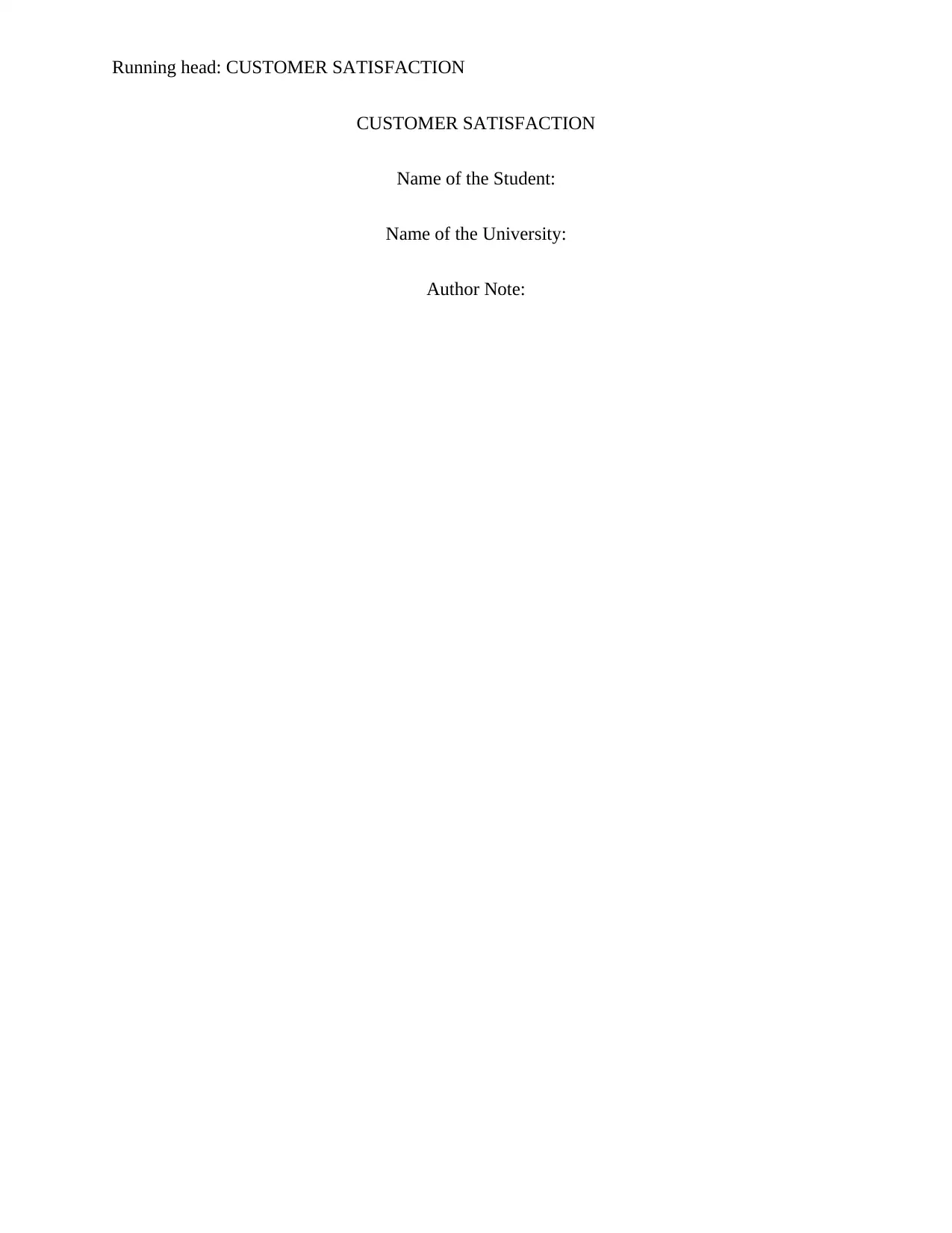
Running head: CUSTOMER SATISFACTION
CUSTOMER SATISFACTION
Name of the Student:
Name of the University:
Author Note:
CUSTOMER SATISFACTION
Name of the Student:
Name of the University:
Author Note:
Paraphrase This Document
Need a fresh take? Get an instant paraphrase of this document with our AI Paraphraser
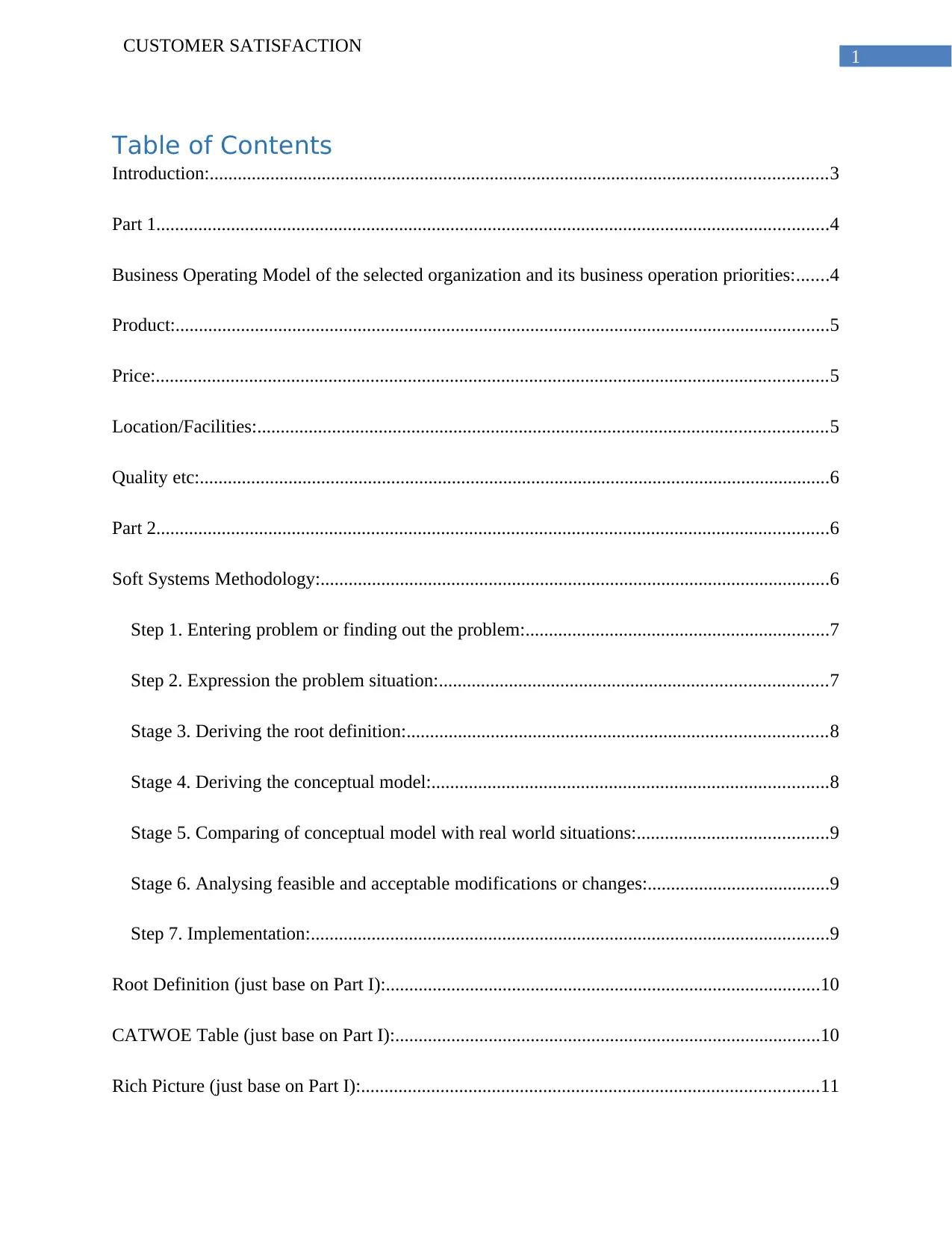
1
CUSTOMER SATISFACTION
Table of Contents
Introduction:....................................................................................................................................3
Part 1................................................................................................................................................4
Business Operating Model of the selected organization and its business operation priorities:.......4
Product:............................................................................................................................................5
Price:................................................................................................................................................5
Location/Facilities:..........................................................................................................................5
Quality etc:.......................................................................................................................................6
Part 2................................................................................................................................................6
Soft Systems Methodology:.............................................................................................................6
Step 1. Entering problem or finding out the problem:.................................................................7
Step 2. Expression the problem situation:...................................................................................7
Stage 3. Deriving the root definition:..........................................................................................8
Stage 4. Deriving the conceptual model:.....................................................................................8
Stage 5. Comparing of conceptual model with real world situations:.........................................9
Stage 6. Analysing feasible and acceptable modifications or changes:.......................................9
Step 7. Implementation:...............................................................................................................9
Root Definition (just base on Part I):.............................................................................................10
CATWOE Table (just base on Part I):...........................................................................................10
Rich Picture (just base on Part I):..................................................................................................11
CUSTOMER SATISFACTION
Table of Contents
Introduction:....................................................................................................................................3
Part 1................................................................................................................................................4
Business Operating Model of the selected organization and its business operation priorities:.......4
Product:............................................................................................................................................5
Price:................................................................................................................................................5
Location/Facilities:..........................................................................................................................5
Quality etc:.......................................................................................................................................6
Part 2................................................................................................................................................6
Soft Systems Methodology:.............................................................................................................6
Step 1. Entering problem or finding out the problem:.................................................................7
Step 2. Expression the problem situation:...................................................................................7
Stage 3. Deriving the root definition:..........................................................................................8
Stage 4. Deriving the conceptual model:.....................................................................................8
Stage 5. Comparing of conceptual model with real world situations:.........................................9
Stage 6. Analysing feasible and acceptable modifications or changes:.......................................9
Step 7. Implementation:...............................................................................................................9
Root Definition (just base on Part I):.............................................................................................10
CATWOE Table (just base on Part I):...........................................................................................10
Rich Picture (just base on Part I):..................................................................................................11
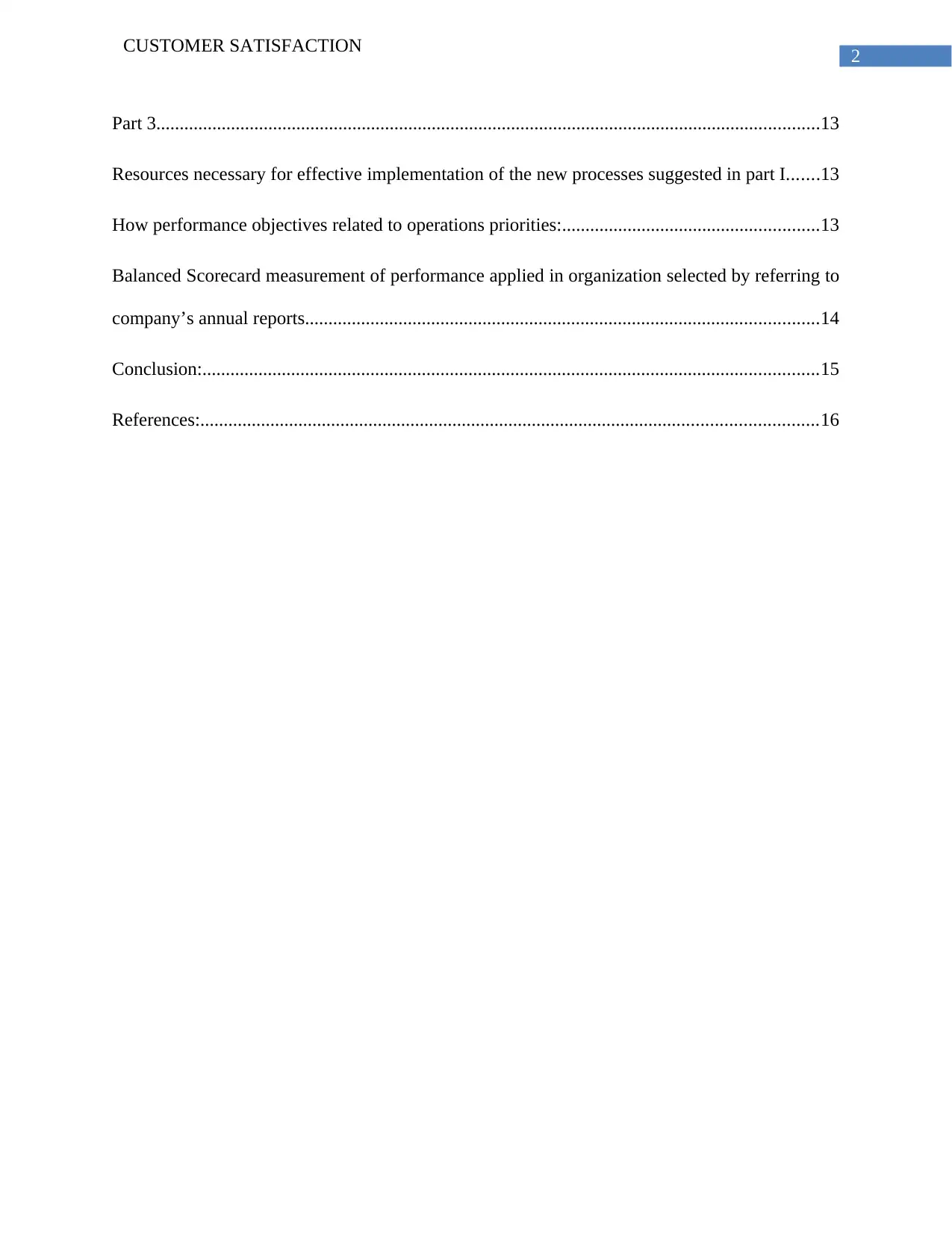
2
CUSTOMER SATISFACTION
Part 3..............................................................................................................................................13
Resources necessary for effective implementation of the new processes suggested in part I.......13
How performance objectives related to operations priorities:.......................................................13
Balanced Scorecard measurement of performance applied in organization selected by referring to
company’s annual reports..............................................................................................................14
Conclusion:....................................................................................................................................15
References:....................................................................................................................................16
CUSTOMER SATISFACTION
Part 3..............................................................................................................................................13
Resources necessary for effective implementation of the new processes suggested in part I.......13
How performance objectives related to operations priorities:.......................................................13
Balanced Scorecard measurement of performance applied in organization selected by referring to
company’s annual reports..............................................................................................................14
Conclusion:....................................................................................................................................15
References:....................................................................................................................................16
⊘ This is a preview!⊘
Do you want full access?
Subscribe today to unlock all pages.

Trusted by 1+ million students worldwide
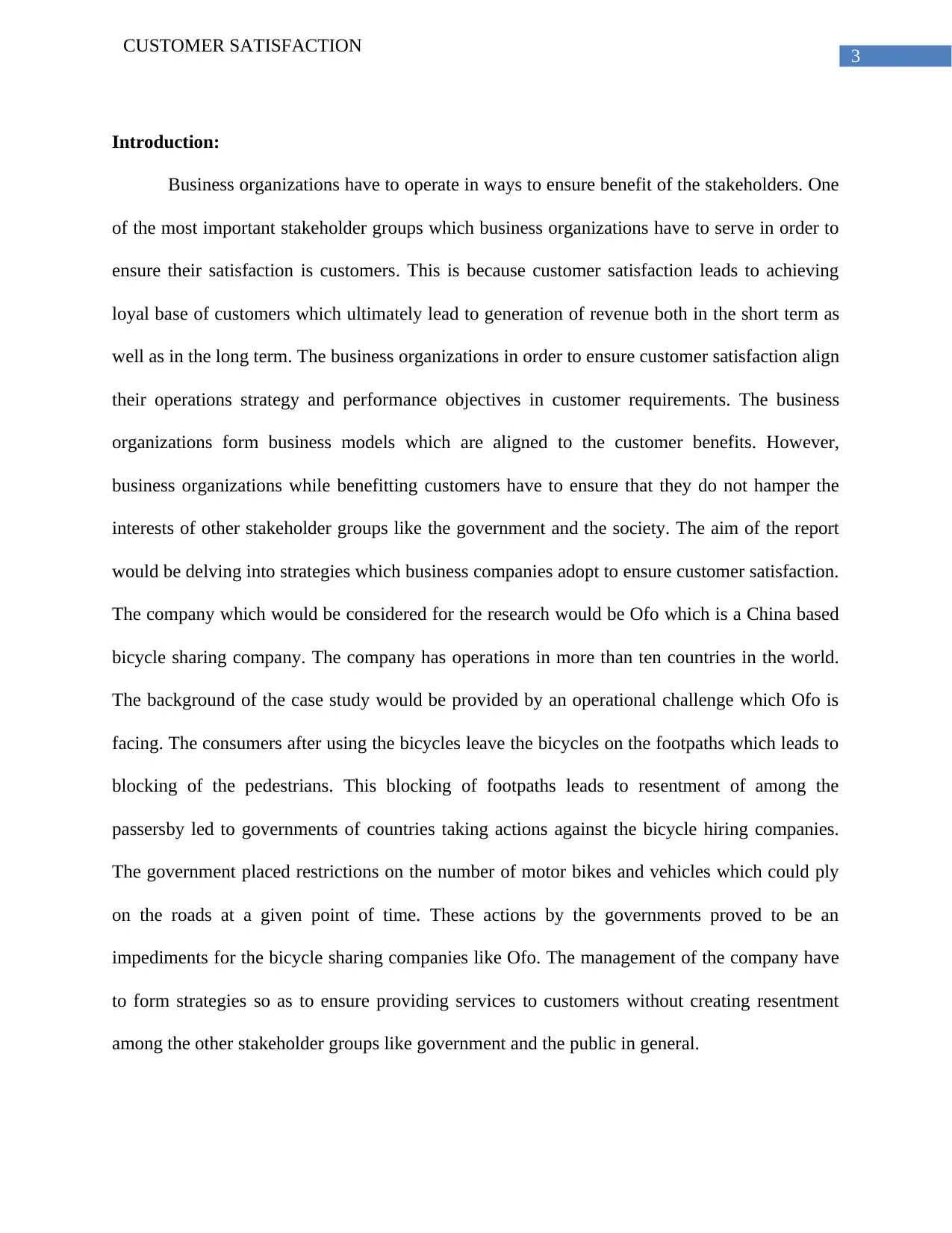
3
CUSTOMER SATISFACTION
Introduction:
Business organizations have to operate in ways to ensure benefit of the stakeholders. One
of the most important stakeholder groups which business organizations have to serve in order to
ensure their satisfaction is customers. This is because customer satisfaction leads to achieving
loyal base of customers which ultimately lead to generation of revenue both in the short term as
well as in the long term. The business organizations in order to ensure customer satisfaction align
their operations strategy and performance objectives in customer requirements. The business
organizations form business models which are aligned to the customer benefits. However,
business organizations while benefitting customers have to ensure that they do not hamper the
interests of other stakeholder groups like the government and the society. The aim of the report
would be delving into strategies which business companies adopt to ensure customer satisfaction.
The company which would be considered for the research would be Ofo which is a China based
bicycle sharing company. The company has operations in more than ten countries in the world.
The background of the case study would be provided by an operational challenge which Ofo is
facing. The consumers after using the bicycles leave the bicycles on the footpaths which leads to
blocking of the pedestrians. This blocking of footpaths leads to resentment of among the
passersby led to governments of countries taking actions against the bicycle hiring companies.
The government placed restrictions on the number of motor bikes and vehicles which could ply
on the roads at a given point of time. These actions by the governments proved to be an
impediments for the bicycle sharing companies like Ofo. The management of the company have
to form strategies so as to ensure providing services to customers without creating resentment
among the other stakeholder groups like government and the public in general.
CUSTOMER SATISFACTION
Introduction:
Business organizations have to operate in ways to ensure benefit of the stakeholders. One
of the most important stakeholder groups which business organizations have to serve in order to
ensure their satisfaction is customers. This is because customer satisfaction leads to achieving
loyal base of customers which ultimately lead to generation of revenue both in the short term as
well as in the long term. The business organizations in order to ensure customer satisfaction align
their operations strategy and performance objectives in customer requirements. The business
organizations form business models which are aligned to the customer benefits. However,
business organizations while benefitting customers have to ensure that they do not hamper the
interests of other stakeholder groups like the government and the society. The aim of the report
would be delving into strategies which business companies adopt to ensure customer satisfaction.
The company which would be considered for the research would be Ofo which is a China based
bicycle sharing company. The company has operations in more than ten countries in the world.
The background of the case study would be provided by an operational challenge which Ofo is
facing. The consumers after using the bicycles leave the bicycles on the footpaths which leads to
blocking of the pedestrians. This blocking of footpaths leads to resentment of among the
passersby led to governments of countries taking actions against the bicycle hiring companies.
The government placed restrictions on the number of motor bikes and vehicles which could ply
on the roads at a given point of time. These actions by the governments proved to be an
impediments for the bicycle sharing companies like Ofo. The management of the company have
to form strategies so as to ensure providing services to customers without creating resentment
among the other stakeholder groups like government and the public in general.
Paraphrase This Document
Need a fresh take? Get an instant paraphrase of this document with our AI Paraphraser
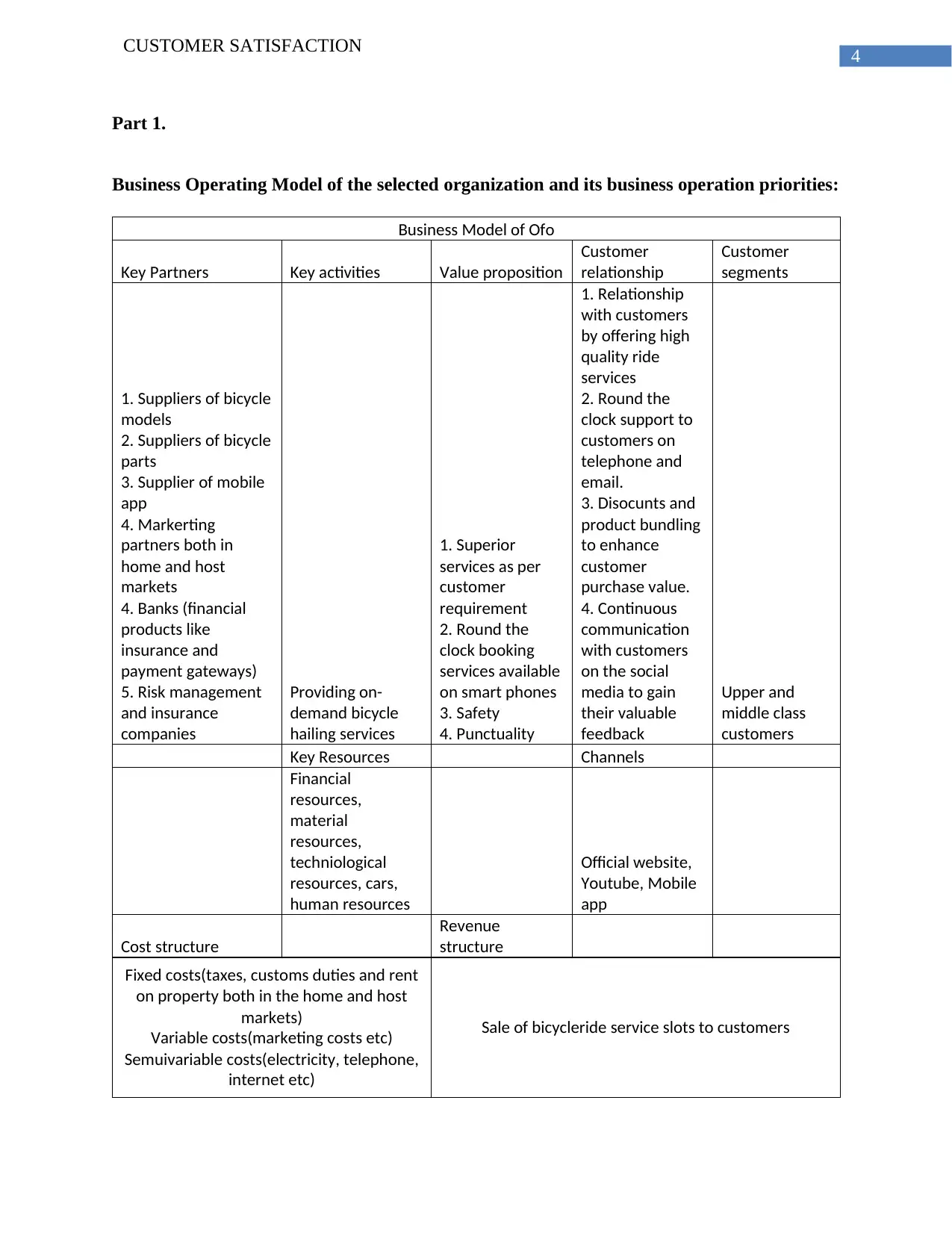
4
CUSTOMER SATISFACTION
Part 1.
Business Operating Model of the selected organization and its business operation priorities:
Business Model of Ofo
Key Partners Key activities Value proposition
Customer
relationship
Customer
segments
1. Suppliers of bicycle
models
2. Suppliers of bicycle
parts
3. Supplier of mobile
app
4. Markerting
partners both in
home and host
markets
4. Banks (financial
products like
insurance and
payment gateways)
5. Risk management
and insurance
companies
Providing on-
demand bicycle
hailing services
1. Superior
services as per
customer
requirement
2. Round the
clock booking
services available
on smart phones
3. Safety
4. Punctuality
1. Relationship
with customers
by offering high
quality ride
services
2. Round the
clock support to
customers on
telephone and
email.
3. Disocunts and
product bundling
to enhance
customer
purchase value.
4. Continuous
communication
with customers
on the social
media to gain
their valuable
feedback
Upper and
middle class
customers
Key Resources Channels
Financial
resources,
material
resources,
techniological
resources, cars,
human resources
Official website,
Youtube, Mobile
app
Cost structure
Revenue
structure
Fixed costs(taxes, customs duties and rent
on property both in the home and host
markets)
Variable costs(marketing costs etc)
Semuivariable costs(electricity, telephone,
internet etc)
Sale of bicycleride service slots to customers
CUSTOMER SATISFACTION
Part 1.
Business Operating Model of the selected organization and its business operation priorities:
Business Model of Ofo
Key Partners Key activities Value proposition
Customer
relationship
Customer
segments
1. Suppliers of bicycle
models
2. Suppliers of bicycle
parts
3. Supplier of mobile
app
4. Markerting
partners both in
home and host
markets
4. Banks (financial
products like
insurance and
payment gateways)
5. Risk management
and insurance
companies
Providing on-
demand bicycle
hailing services
1. Superior
services as per
customer
requirement
2. Round the
clock booking
services available
on smart phones
3. Safety
4. Punctuality
1. Relationship
with customers
by offering high
quality ride
services
2. Round the
clock support to
customers on
telephone and
email.
3. Disocunts and
product bundling
to enhance
customer
purchase value.
4. Continuous
communication
with customers
on the social
media to gain
their valuable
feedback
Upper and
middle class
customers
Key Resources Channels
Financial
resources,
material
resources,
techniological
resources, cars,
human resources
Official website,
Youtube, Mobile
app
Cost structure
Revenue
structure
Fixed costs(taxes, customs duties and rent
on property both in the home and host
markets)
Variable costs(marketing costs etc)
Semuivariable costs(electricity, telephone,
internet etc)
Sale of bicycleride service slots to customers
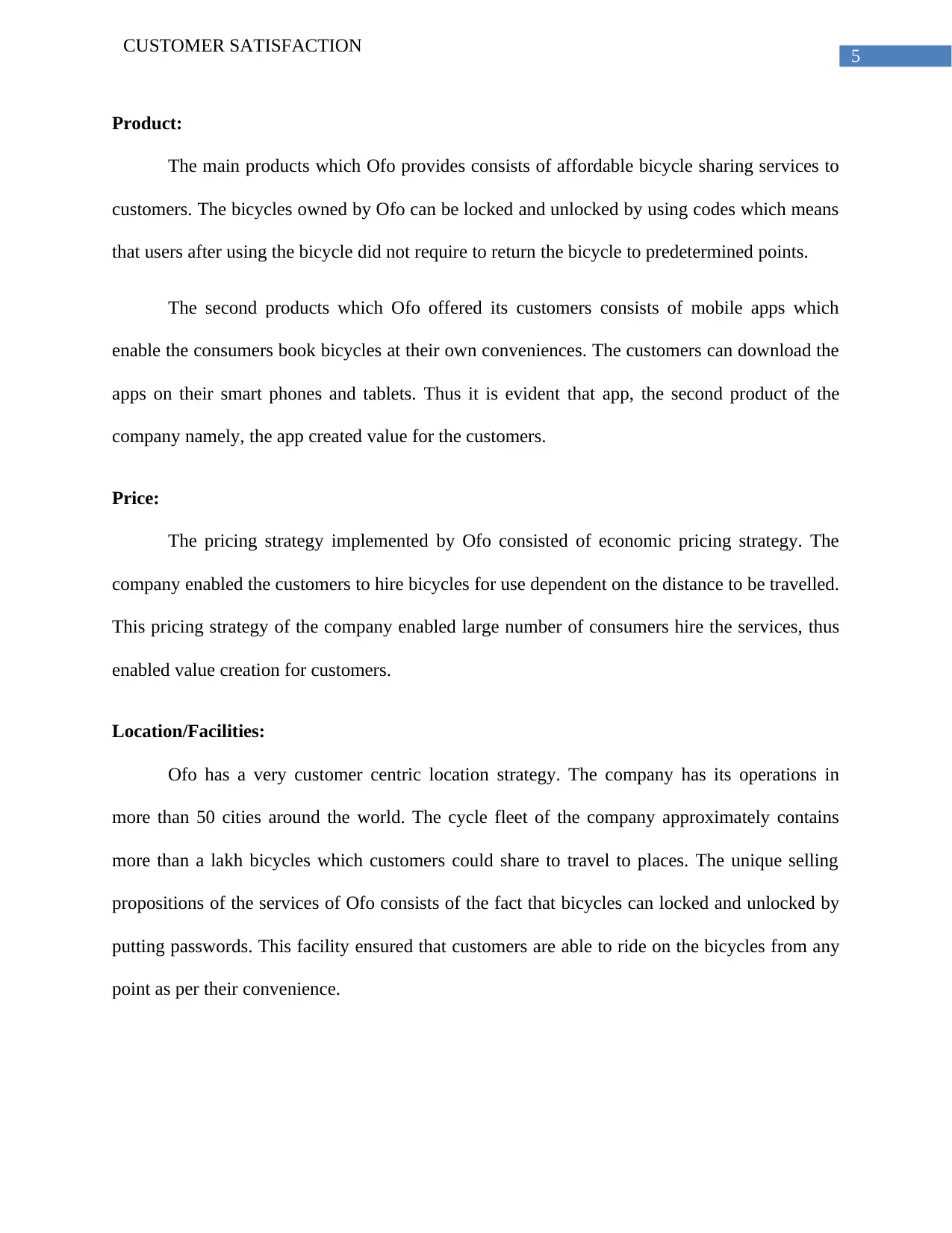
5
CUSTOMER SATISFACTION
Product:
The main products which Ofo provides consists of affordable bicycle sharing services to
customers. The bicycles owned by Ofo can be locked and unlocked by using codes which means
that users after using the bicycle did not require to return the bicycle to predetermined points.
The second products which Ofo offered its customers consists of mobile apps which
enable the consumers book bicycles at their own conveniences. The customers can download the
apps on their smart phones and tablets. Thus it is evident that app, the second product of the
company namely, the app created value for the customers.
Price:
The pricing strategy implemented by Ofo consisted of economic pricing strategy. The
company enabled the customers to hire bicycles for use dependent on the distance to be travelled.
This pricing strategy of the company enabled large number of consumers hire the services, thus
enabled value creation for customers.
Location/Facilities:
Ofo has a very customer centric location strategy. The company has its operations in
more than 50 cities around the world. The cycle fleet of the company approximately contains
more than a lakh bicycles which customers could share to travel to places. The unique selling
propositions of the services of Ofo consists of the fact that bicycles can locked and unlocked by
putting passwords. This facility ensured that customers are able to ride on the bicycles from any
point as per their convenience.
CUSTOMER SATISFACTION
Product:
The main products which Ofo provides consists of affordable bicycle sharing services to
customers. The bicycles owned by Ofo can be locked and unlocked by using codes which means
that users after using the bicycle did not require to return the bicycle to predetermined points.
The second products which Ofo offered its customers consists of mobile apps which
enable the consumers book bicycles at their own conveniences. The customers can download the
apps on their smart phones and tablets. Thus it is evident that app, the second product of the
company namely, the app created value for the customers.
Price:
The pricing strategy implemented by Ofo consisted of economic pricing strategy. The
company enabled the customers to hire bicycles for use dependent on the distance to be travelled.
This pricing strategy of the company enabled large number of consumers hire the services, thus
enabled value creation for customers.
Location/Facilities:
Ofo has a very customer centric location strategy. The company has its operations in
more than 50 cities around the world. The cycle fleet of the company approximately contains
more than a lakh bicycles which customers could share to travel to places. The unique selling
propositions of the services of Ofo consists of the fact that bicycles can locked and unlocked by
putting passwords. This facility ensured that customers are able to ride on the bicycles from any
point as per their convenience.
⊘ This is a preview!⊘
Do you want full access?
Subscribe today to unlock all pages.

Trusted by 1+ million students worldwide
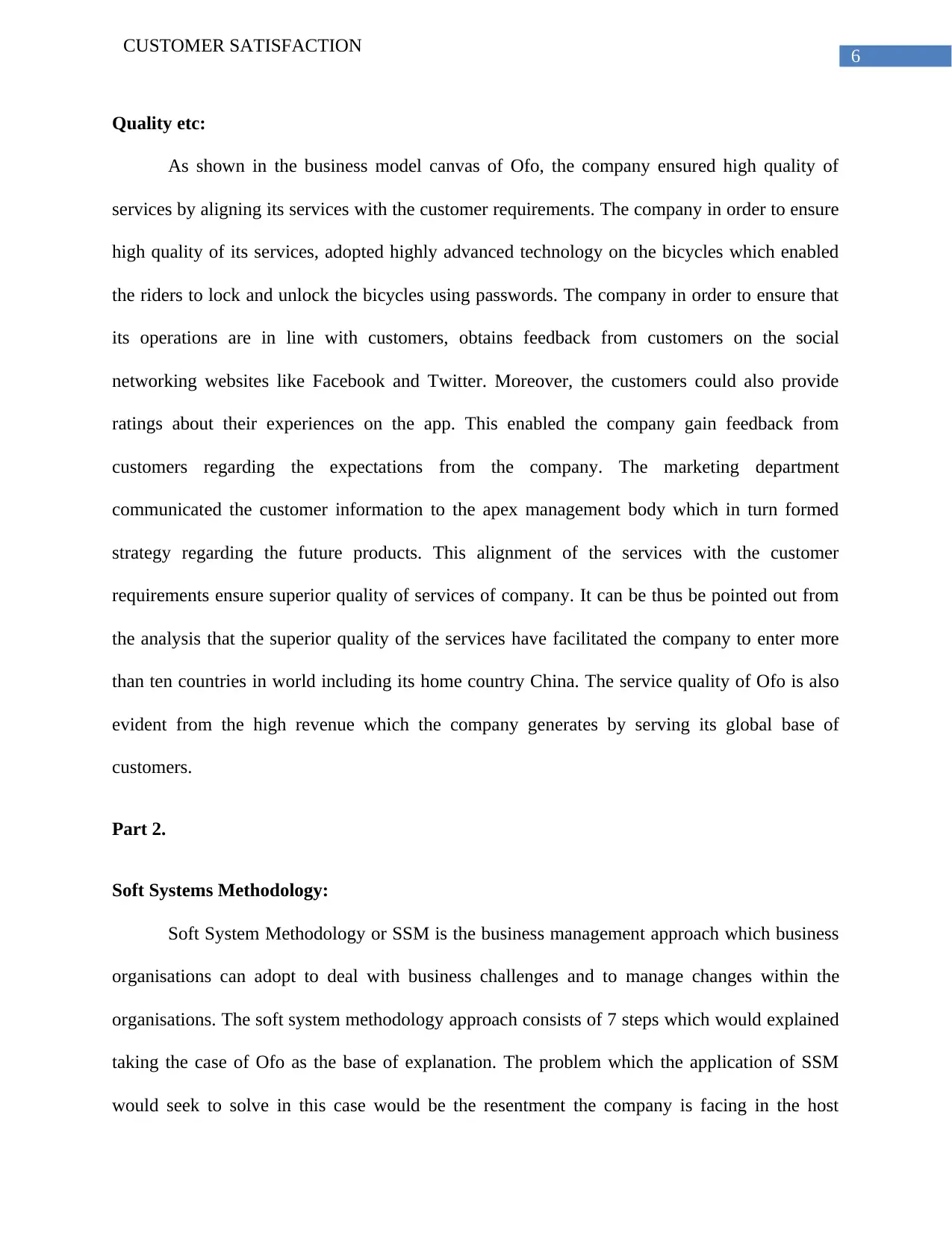
6
CUSTOMER SATISFACTION
Quality etc:
As shown in the business model canvas of Ofo, the company ensured high quality of
services by aligning its services with the customer requirements. The company in order to ensure
high quality of its services, adopted highly advanced technology on the bicycles which enabled
the riders to lock and unlock the bicycles using passwords. The company in order to ensure that
its operations are in line with customers, obtains feedback from customers on the social
networking websites like Facebook and Twitter. Moreover, the customers could also provide
ratings about their experiences on the app. This enabled the company gain feedback from
customers regarding the expectations from the company. The marketing department
communicated the customer information to the apex management body which in turn formed
strategy regarding the future products. This alignment of the services with the customer
requirements ensure superior quality of services of company. It can be thus be pointed out from
the analysis that the superior quality of the services have facilitated the company to enter more
than ten countries in world including its home country China. The service quality of Ofo is also
evident from the high revenue which the company generates by serving its global base of
customers.
Part 2.
Soft Systems Methodology:
Soft System Methodology or SSM is the business management approach which business
organisations can adopt to deal with business challenges and to manage changes within the
organisations. The soft system methodology approach consists of 7 steps which would explained
taking the case of Ofo as the base of explanation. The problem which the application of SSM
would seek to solve in this case would be the resentment the company is facing in the host
CUSTOMER SATISFACTION
Quality etc:
As shown in the business model canvas of Ofo, the company ensured high quality of
services by aligning its services with the customer requirements. The company in order to ensure
high quality of its services, adopted highly advanced technology on the bicycles which enabled
the riders to lock and unlock the bicycles using passwords. The company in order to ensure that
its operations are in line with customers, obtains feedback from customers on the social
networking websites like Facebook and Twitter. Moreover, the customers could also provide
ratings about their experiences on the app. This enabled the company gain feedback from
customers regarding the expectations from the company. The marketing department
communicated the customer information to the apex management body which in turn formed
strategy regarding the future products. This alignment of the services with the customer
requirements ensure superior quality of services of company. It can be thus be pointed out from
the analysis that the superior quality of the services have facilitated the company to enter more
than ten countries in world including its home country China. The service quality of Ofo is also
evident from the high revenue which the company generates by serving its global base of
customers.
Part 2.
Soft Systems Methodology:
Soft System Methodology or SSM is the business management approach which business
organisations can adopt to deal with business challenges and to manage changes within the
organisations. The soft system methodology approach consists of 7 steps which would explained
taking the case of Ofo as the base of explanation. The problem which the application of SSM
would seek to solve in this case would be the resentment the company is facing in the host
Paraphrase This Document
Need a fresh take? Get an instant paraphrase of this document with our AI Paraphraser
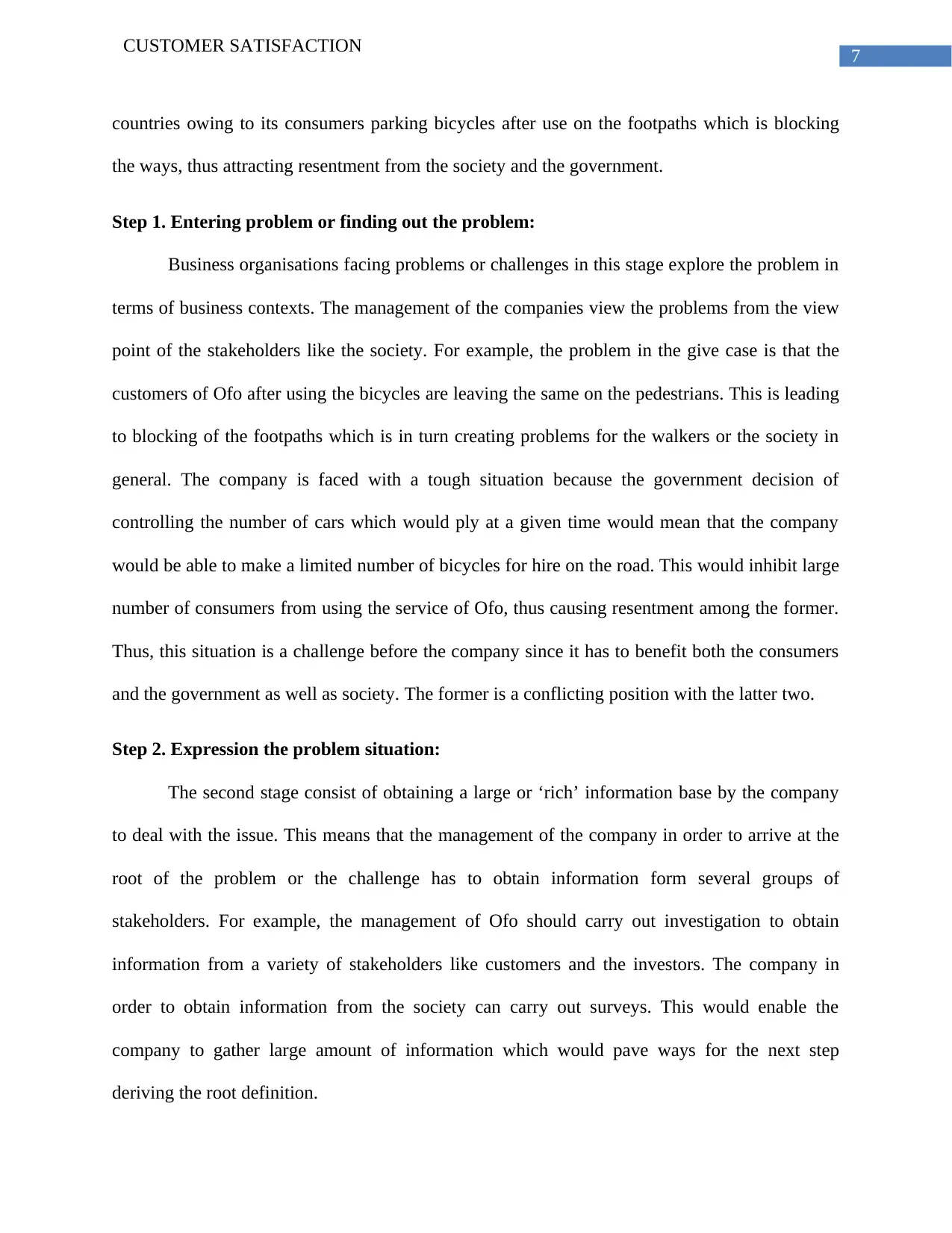
7
CUSTOMER SATISFACTION
countries owing to its consumers parking bicycles after use on the footpaths which is blocking
the ways, thus attracting resentment from the society and the government.
Step 1. Entering problem or finding out the problem:
Business organisations facing problems or challenges in this stage explore the problem in
terms of business contexts. The management of the companies view the problems from the view
point of the stakeholders like the society. For example, the problem in the give case is that the
customers of Ofo after using the bicycles are leaving the same on the pedestrians. This is leading
to blocking of the footpaths which is in turn creating problems for the walkers or the society in
general. The company is faced with a tough situation because the government decision of
controlling the number of cars which would ply at a given time would mean that the company
would be able to make a limited number of bicycles for hire on the road. This would inhibit large
number of consumers from using the service of Ofo, thus causing resentment among the former.
Thus, this situation is a challenge before the company since it has to benefit both the consumers
and the government as well as society. The former is a conflicting position with the latter two.
Step 2. Expression the problem situation:
The second stage consist of obtaining a large or ‘rich’ information base by the company
to deal with the issue. This means that the management of the company in order to arrive at the
root of the problem or the challenge has to obtain information form several groups of
stakeholders. For example, the management of Ofo should carry out investigation to obtain
information from a variety of stakeholders like customers and the investors. The company in
order to obtain information from the society can carry out surveys. This would enable the
company to gather large amount of information which would pave ways for the next step
deriving the root definition.
CUSTOMER SATISFACTION
countries owing to its consumers parking bicycles after use on the footpaths which is blocking
the ways, thus attracting resentment from the society and the government.
Step 1. Entering problem or finding out the problem:
Business organisations facing problems or challenges in this stage explore the problem in
terms of business contexts. The management of the companies view the problems from the view
point of the stakeholders like the society. For example, the problem in the give case is that the
customers of Ofo after using the bicycles are leaving the same on the pedestrians. This is leading
to blocking of the footpaths which is in turn creating problems for the walkers or the society in
general. The company is faced with a tough situation because the government decision of
controlling the number of cars which would ply at a given time would mean that the company
would be able to make a limited number of bicycles for hire on the road. This would inhibit large
number of consumers from using the service of Ofo, thus causing resentment among the former.
Thus, this situation is a challenge before the company since it has to benefit both the consumers
and the government as well as society. The former is a conflicting position with the latter two.
Step 2. Expression the problem situation:
The second stage consist of obtaining a large or ‘rich’ information base by the company
to deal with the issue. This means that the management of the company in order to arrive at the
root of the problem or the challenge has to obtain information form several groups of
stakeholders. For example, the management of Ofo should carry out investigation to obtain
information from a variety of stakeholders like customers and the investors. The company in
order to obtain information from the society can carry out surveys. This would enable the
company to gather large amount of information which would pave ways for the next step
deriving the root definition.
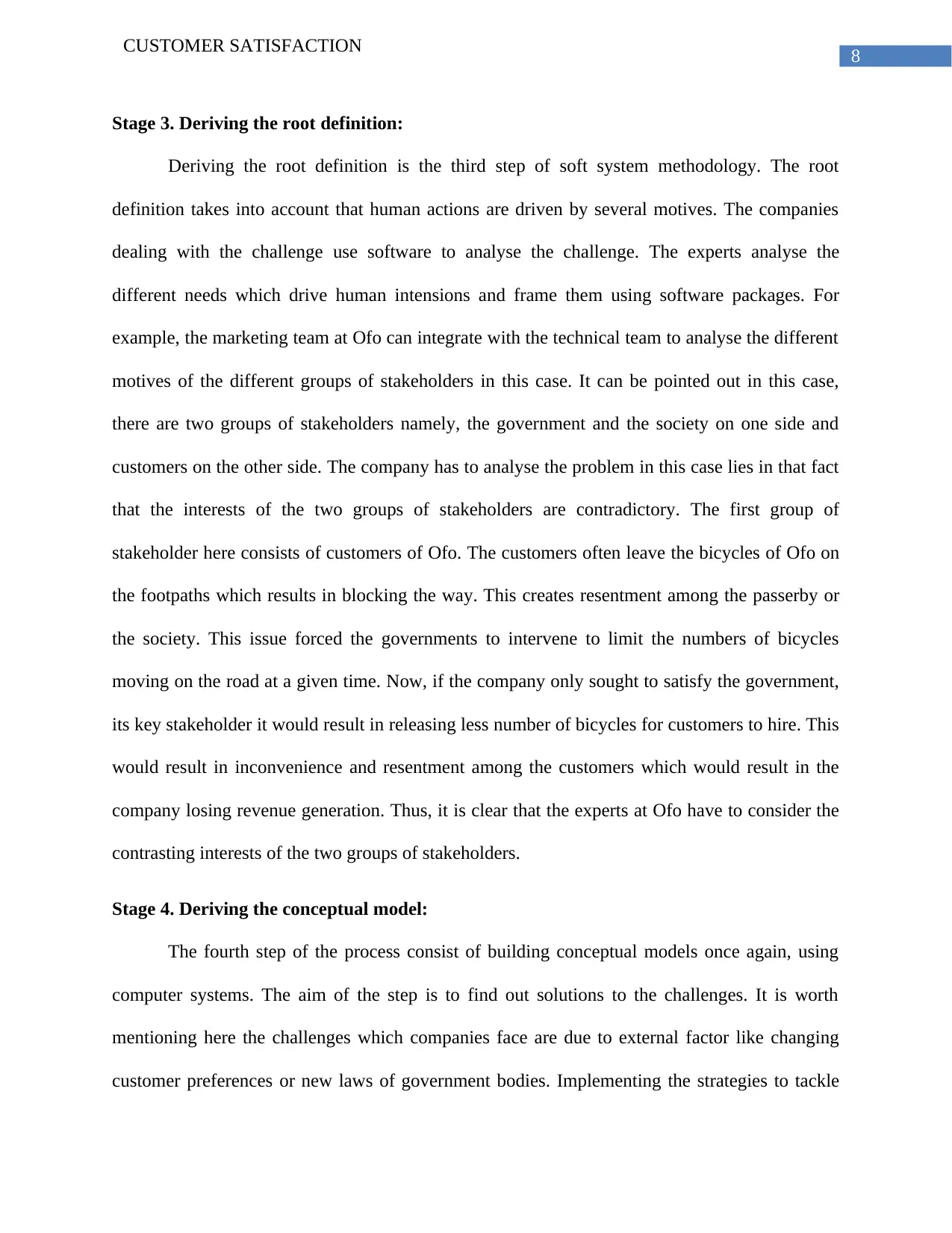
8
CUSTOMER SATISFACTION
Stage 3. Deriving the root definition:
Deriving the root definition is the third step of soft system methodology. The root
definition takes into account that human actions are driven by several motives. The companies
dealing with the challenge use software to analyse the challenge. The experts analyse the
different needs which drive human intensions and frame them using software packages. For
example, the marketing team at Ofo can integrate with the technical team to analyse the different
motives of the different groups of stakeholders in this case. It can be pointed out in this case,
there are two groups of stakeholders namely, the government and the society on one side and
customers on the other side. The company has to analyse the problem in this case lies in that fact
that the interests of the two groups of stakeholders are contradictory. The first group of
stakeholder here consists of customers of Ofo. The customers often leave the bicycles of Ofo on
the footpaths which results in blocking the way. This creates resentment among the passerby or
the society. This issue forced the governments to intervene to limit the numbers of bicycles
moving on the road at a given time. Now, if the company only sought to satisfy the government,
its key stakeholder it would result in releasing less number of bicycles for customers to hire. This
would result in inconvenience and resentment among the customers which would result in the
company losing revenue generation. Thus, it is clear that the experts at Ofo have to consider the
contrasting interests of the two groups of stakeholders.
Stage 4. Deriving the conceptual model:
The fourth step of the process consist of building conceptual models once again, using
computer systems. The aim of the step is to find out solutions to the challenges. It is worth
mentioning here the challenges which companies face are due to external factor like changing
customer preferences or new laws of government bodies. Implementing the strategies to tackle
CUSTOMER SATISFACTION
Stage 3. Deriving the root definition:
Deriving the root definition is the third step of soft system methodology. The root
definition takes into account that human actions are driven by several motives. The companies
dealing with the challenge use software to analyse the challenge. The experts analyse the
different needs which drive human intensions and frame them using software packages. For
example, the marketing team at Ofo can integrate with the technical team to analyse the different
motives of the different groups of stakeholders in this case. It can be pointed out in this case,
there are two groups of stakeholders namely, the government and the society on one side and
customers on the other side. The company has to analyse the problem in this case lies in that fact
that the interests of the two groups of stakeholders are contradictory. The first group of
stakeholder here consists of customers of Ofo. The customers often leave the bicycles of Ofo on
the footpaths which results in blocking the way. This creates resentment among the passerby or
the society. This issue forced the governments to intervene to limit the numbers of bicycles
moving on the road at a given time. Now, if the company only sought to satisfy the government,
its key stakeholder it would result in releasing less number of bicycles for customers to hire. This
would result in inconvenience and resentment among the customers which would result in the
company losing revenue generation. Thus, it is clear that the experts at Ofo have to consider the
contrasting interests of the two groups of stakeholders.
Stage 4. Deriving the conceptual model:
The fourth step of the process consist of building conceptual models once again, using
computer systems. The aim of the step is to find out solutions to the challenges. It is worth
mentioning here the challenges which companies face are due to external factor like changing
customer preferences or new laws of government bodies. Implementing the strategies to tackle
⊘ This is a preview!⊘
Do you want full access?
Subscribe today to unlock all pages.

Trusted by 1+ million students worldwide
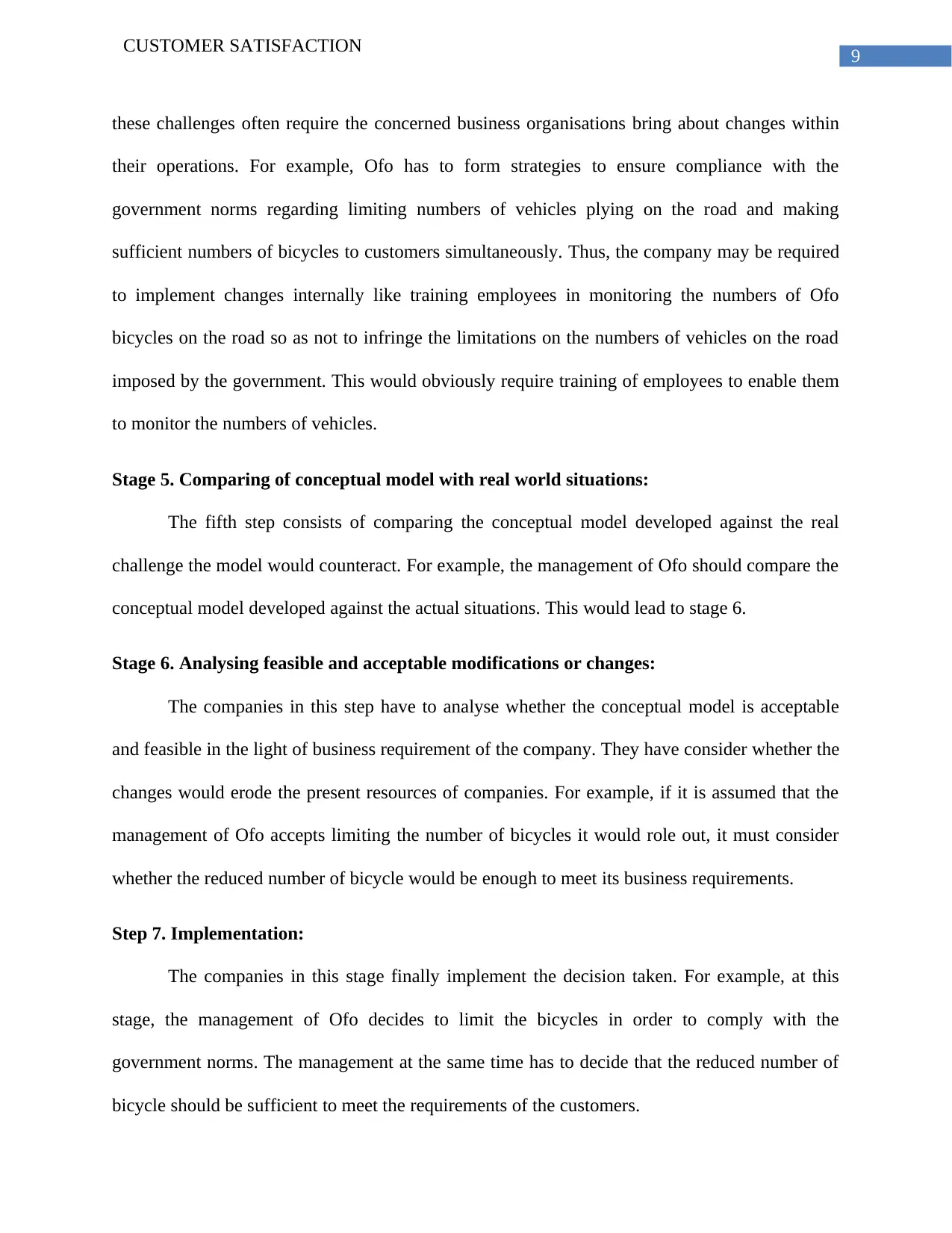
9
CUSTOMER SATISFACTION
these challenges often require the concerned business organisations bring about changes within
their operations. For example, Ofo has to form strategies to ensure compliance with the
government norms regarding limiting numbers of vehicles plying on the road and making
sufficient numbers of bicycles to customers simultaneously. Thus, the company may be required
to implement changes internally like training employees in monitoring the numbers of Ofo
bicycles on the road so as not to infringe the limitations on the numbers of vehicles on the road
imposed by the government. This would obviously require training of employees to enable them
to monitor the numbers of vehicles.
Stage 5. Comparing of conceptual model with real world situations:
The fifth step consists of comparing the conceptual model developed against the real
challenge the model would counteract. For example, the management of Ofo should compare the
conceptual model developed against the actual situations. This would lead to stage 6.
Stage 6. Analysing feasible and acceptable modifications or changes:
The companies in this step have to analyse whether the conceptual model is acceptable
and feasible in the light of business requirement of the company. They have consider whether the
changes would erode the present resources of companies. For example, if it is assumed that the
management of Ofo accepts limiting the number of bicycles it would role out, it must consider
whether the reduced number of bicycle would be enough to meet its business requirements.
Step 7. Implementation:
The companies in this stage finally implement the decision taken. For example, at this
stage, the management of Ofo decides to limit the bicycles in order to comply with the
government norms. The management at the same time has to decide that the reduced number of
bicycle should be sufficient to meet the requirements of the customers.
CUSTOMER SATISFACTION
these challenges often require the concerned business organisations bring about changes within
their operations. For example, Ofo has to form strategies to ensure compliance with the
government norms regarding limiting numbers of vehicles plying on the road and making
sufficient numbers of bicycles to customers simultaneously. Thus, the company may be required
to implement changes internally like training employees in monitoring the numbers of Ofo
bicycles on the road so as not to infringe the limitations on the numbers of vehicles on the road
imposed by the government. This would obviously require training of employees to enable them
to monitor the numbers of vehicles.
Stage 5. Comparing of conceptual model with real world situations:
The fifth step consists of comparing the conceptual model developed against the real
challenge the model would counteract. For example, the management of Ofo should compare the
conceptual model developed against the actual situations. This would lead to stage 6.
Stage 6. Analysing feasible and acceptable modifications or changes:
The companies in this step have to analyse whether the conceptual model is acceptable
and feasible in the light of business requirement of the company. They have consider whether the
changes would erode the present resources of companies. For example, if it is assumed that the
management of Ofo accepts limiting the number of bicycles it would role out, it must consider
whether the reduced number of bicycle would be enough to meet its business requirements.
Step 7. Implementation:
The companies in this stage finally implement the decision taken. For example, at this
stage, the management of Ofo decides to limit the bicycles in order to comply with the
government norms. The management at the same time has to decide that the reduced number of
bicycle should be sufficient to meet the requirements of the customers.
Paraphrase This Document
Need a fresh take? Get an instant paraphrase of this document with our AI Paraphraser
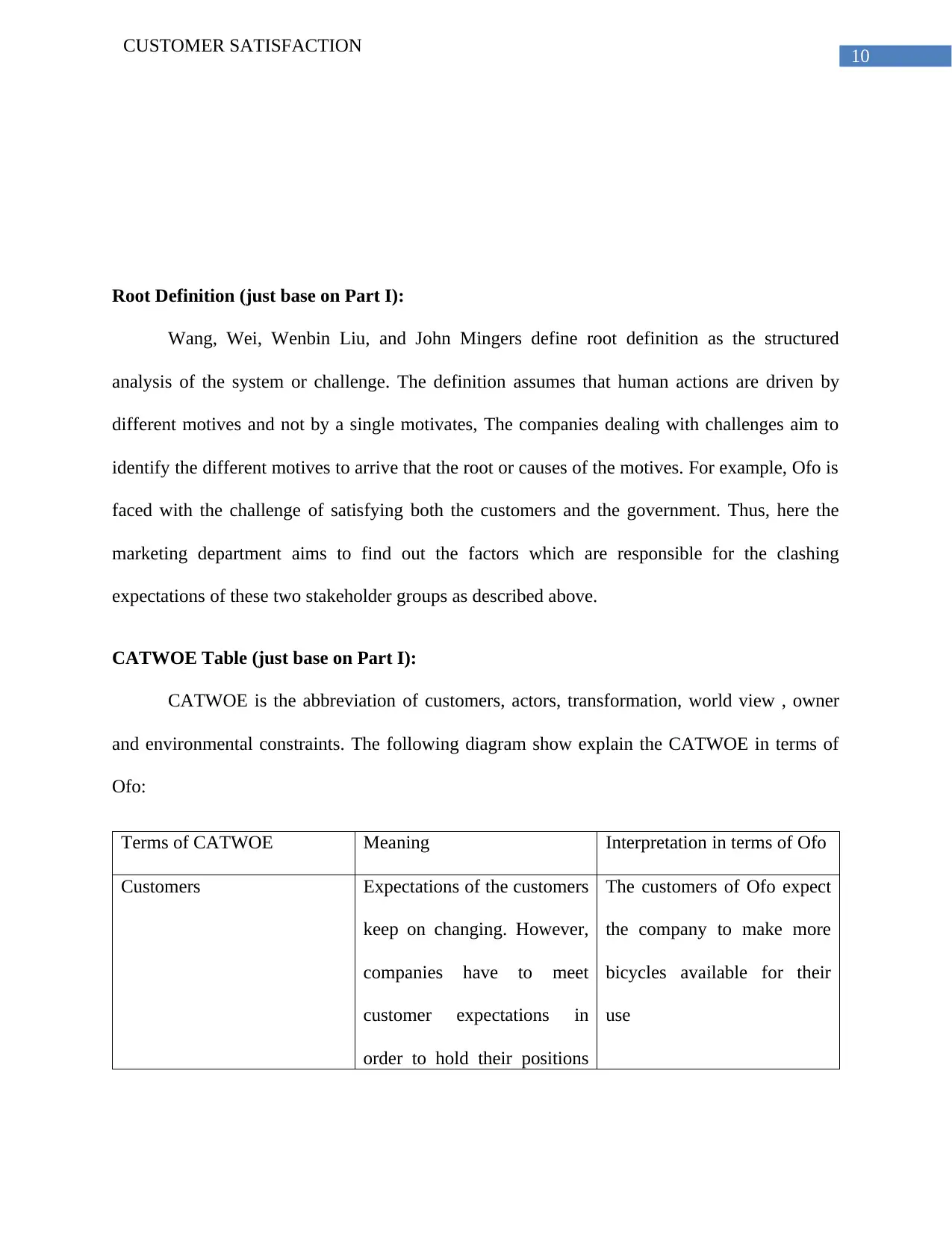
10
CUSTOMER SATISFACTION
Root Definition (just base on Part I):
Wang, Wei, Wenbin Liu, and John Mingers define root definition as the structured
analysis of the system or challenge. The definition assumes that human actions are driven by
different motives and not by a single motivates, The companies dealing with challenges aim to
identify the different motives to arrive that the root or causes of the motives. For example, Ofo is
faced with the challenge of satisfying both the customers and the government. Thus, here the
marketing department aims to find out the factors which are responsible for the clashing
expectations of these two stakeholder groups as described above.
CATWOE Table (just base on Part I):
CATWOE is the abbreviation of customers, actors, transformation, world view , owner
and environmental constraints. The following diagram show explain the CATWOE in terms of
Ofo:
Terms of CATWOE Meaning Interpretation in terms of Ofo
Customers Expectations of the customers
keep on changing. However,
companies have to meet
customer expectations in
order to hold their positions
The customers of Ofo expect
the company to make more
bicycles available for their
use
CUSTOMER SATISFACTION
Root Definition (just base on Part I):
Wang, Wei, Wenbin Liu, and John Mingers define root definition as the structured
analysis of the system or challenge. The definition assumes that human actions are driven by
different motives and not by a single motivates, The companies dealing with challenges aim to
identify the different motives to arrive that the root or causes of the motives. For example, Ofo is
faced with the challenge of satisfying both the customers and the government. Thus, here the
marketing department aims to find out the factors which are responsible for the clashing
expectations of these two stakeholder groups as described above.
CATWOE Table (just base on Part I):
CATWOE is the abbreviation of customers, actors, transformation, world view , owner
and environmental constraints. The following diagram show explain the CATWOE in terms of
Ofo:
Terms of CATWOE Meaning Interpretation in terms of Ofo
Customers Expectations of the customers
keep on changing. However,
companies have to meet
customer expectations in
order to hold their positions
The customers of Ofo expect
the company to make more
bicycles available for their
use
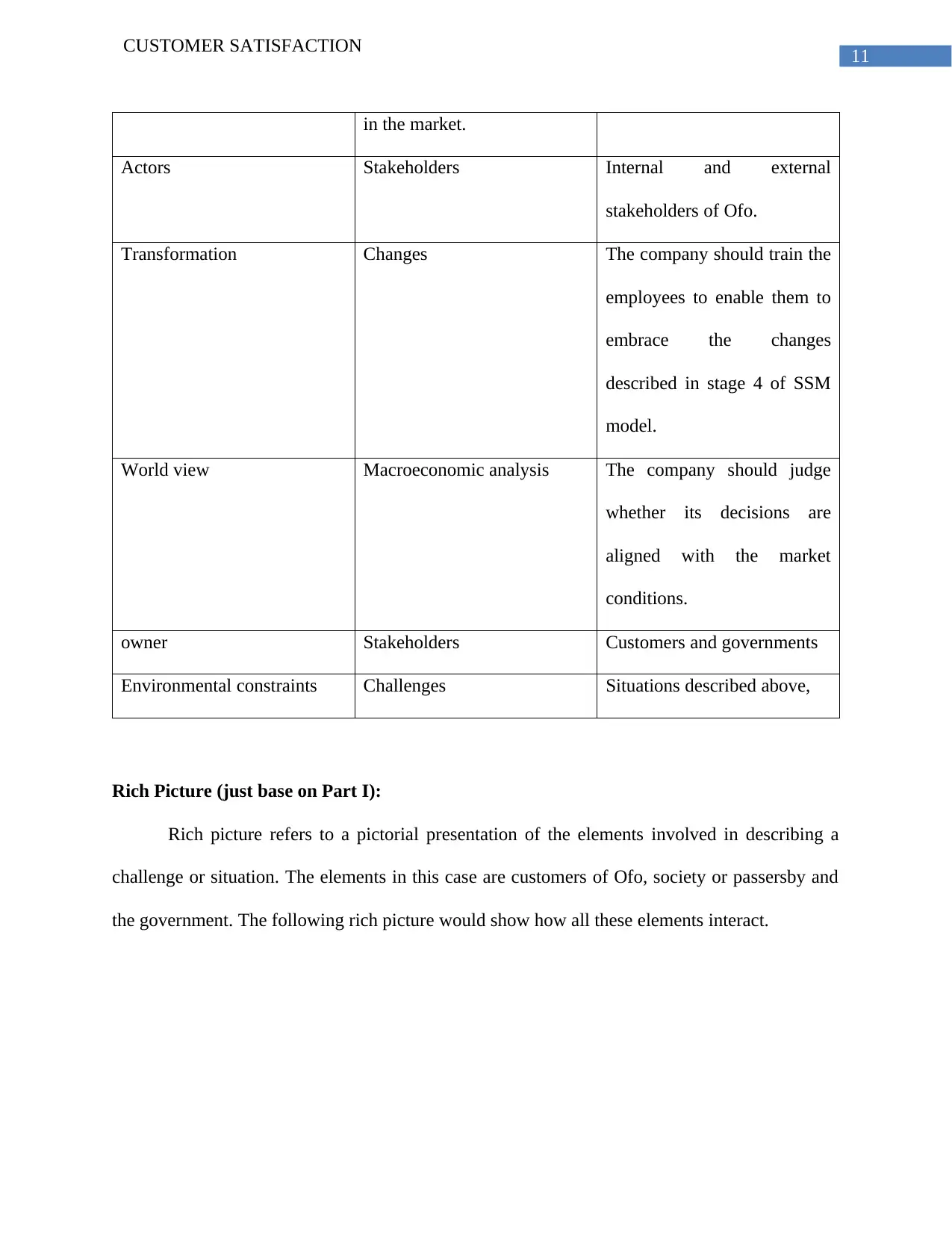
11
CUSTOMER SATISFACTION
in the market.
Actors Stakeholders Internal and external
stakeholders of Ofo.
Transformation Changes The company should train the
employees to enable them to
embrace the changes
described in stage 4 of SSM
model.
World view Macroeconomic analysis The company should judge
whether its decisions are
aligned with the market
conditions.
owner Stakeholders Customers and governments
Environmental constraints Challenges Situations described above,
Rich Picture (just base on Part I):
Rich picture refers to a pictorial presentation of the elements involved in describing a
challenge or situation. The elements in this case are customers of Ofo, society or passersby and
the government. The following rich picture would show how all these elements interact.
CUSTOMER SATISFACTION
in the market.
Actors Stakeholders Internal and external
stakeholders of Ofo.
Transformation Changes The company should train the
employees to enable them to
embrace the changes
described in stage 4 of SSM
model.
World view Macroeconomic analysis The company should judge
whether its decisions are
aligned with the market
conditions.
owner Stakeholders Customers and governments
Environmental constraints Challenges Situations described above,
Rich Picture (just base on Part I):
Rich picture refers to a pictorial presentation of the elements involved in describing a
challenge or situation. The elements in this case are customers of Ofo, society or passersby and
the government. The following rich picture would show how all these elements interact.
⊘ This is a preview!⊘
Do you want full access?
Subscribe today to unlock all pages.

Trusted by 1+ million students worldwide
1 out of 17
Related Documents
Your All-in-One AI-Powered Toolkit for Academic Success.
+13062052269
info@desklib.com
Available 24*7 on WhatsApp / Email
![[object Object]](/_next/static/media/star-bottom.7253800d.svg)
Unlock your academic potential
Copyright © 2020–2025 A2Z Services. All Rights Reserved. Developed and managed by ZUCOL.





